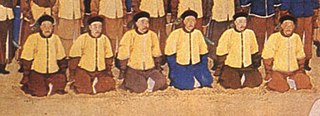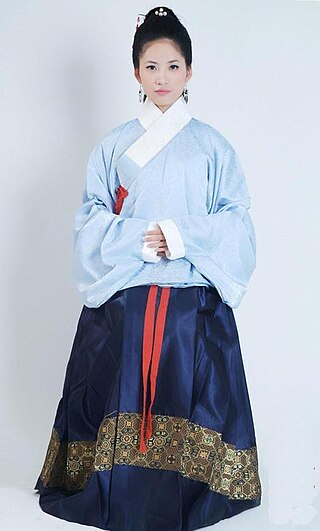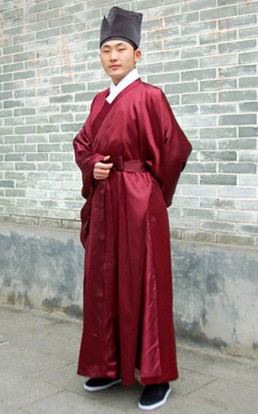
Cheongsam or zansae, also known as the qipao and sometimes referred to as the mandarin gown, is a Chinese dress worn by women which takes inspiration from the qizhuang, the ethnic clothing of the Manchu people. The cheongsam is most often seen as a longer, figure-fitting, one piece garment with a standing collar, an asymmetric, left-over-right opening and two side slits, and embellished with Chinese frog fasteners on the lapel and the collar. It was developed in the 1920s and evolved in shapes and design over years. It was popular in China from the 1920s to 1960s, overlapping with the Republican era, and was popularized by Chinese socialites and high society women in Shanghai. Although the cheongsam is sometimes seen as traditional Chinese clothing, it continues to evolve with the times, responding to changes in contemporary modern life.

Changshan, also known as changpao, and dagua, is a form of paofu, Chinese robe, which was derived from the Qing dynasty qizhuang, the traditional dress of the Manchu people, which were worn by Manchu men. The changshan was actually developed by the Han Chinese through the modification of their own Ming dynasty's Hanfu by adopting some Manchu men's clothing elements in one of their Hanfuchangshan. In function, the changshan is considered the male equivalent of the women's cheongsam. The changshan was often worn by men with a magua, also commonly translated as "riding jacket" in English language.
Formal wear or full dress is the Western dress code category applicable for the most formal occasions, such as weddings, christenings, confirmations, funerals, Easter and Christmas traditions, in addition to certain state dinners, audiences, balls, and horse racing events. Generally permitted other alternatives, though, are the most formal versions of ceremonial dresses, full dress uniforms, religious clothing, national costumes, and most rarely frock coats. In addition, formal wear is often instructed to be worn with official full size orders and medals.

A mandarin collar, standing collar, Nehru collar, band collar or choker collar is a short unfolded stand-up collar style on a shirt or jacket. The style derives its Western name from the mandarin bureaucrats in Qing-era China that employed it as part of their uniform.

Tangzhuang, sometimes called Tang suit, is a kind of Chinese jacket with Manchu origins and Han influences, characterized with a mandarin collar closing at the front with frog buttons. It is an updated form of the Qing magua, itself a more fashionable adaptation of the riding jacket once worn by Manchu horsemen. Nowadays, the tangzhuang is one of the main formal clothing worn by Chinese men on various occasions; overseas Chinese also wear it as a form of fashion or to express their cultural identity.

The imperial yellow jacket was a symbol of high honour during China's Qing dynasty. As yellow was a forbidden color, representing the Emperor, the jacket was given only to high-ranking officials and to the Emperor's body guards.

The magoja (Korean: 마고자) is a type of long jacket worn with hanbok, the traditional clothing of Korea, and is usually worn on top of the jeogori. It is also called magwae and while it was originally a male garment, it is now considered a unisex article of clothing. The magoja was originally a Manchu style of clothing, but was introduced after Heungseon Daewongun, father of King Gojong, returned from political exile in Manchuria in 1887. The magoja is derived from the magwae that he wore at that time to protect against the cold weather of the region. Due to its warmth and the fact that it's easy to wear, the magoja's popularity spread throughout Korea. It is also called "deot jeogori".

Ruqun is a set of attire in Hanfu which consists of a short jacket typically called ru worn under a long Chinese skirt called qun. However, when use as a general term, ruqun can broadly describe a set of attire which consists of a separated upper garment and a wrap-around lower skirt, or yichang, in which yi means the "upper garment" and the chang means the "lower garment". In a broad sense, ruqun can include the shanqun and aoqun in its definition.

Chang-ao, lit. translated as "long jacket" or "long ao", is a historical long-length, Chinese upper garment called ao (袄), which was worn by women. It is also known as da ao (大袄) and chang ru which appears to be the precursor of the ao.
A yuanlingshan is a type of round-collared upper garment in the traditional Chinese style of clothing known as Hanfu; it is also referred to as a yuanlingpao or a panlingpao when used as a robe. The yuanlingshan and yuanlingpao were both developed under the influence of ancient Chinese clothing, known as Hufu, originating from the Donghu people during the early Han dynasty and later by the Wuhu, including the Xianbei people, during the Six Dynasties period. The yuanlingpao is an article of formal attire primarily worn by men, although in certain dynasties, such as the Tang dynasty, it was also fashionable for women to wear. In the Tang dynasty, the yuanlingpao could be transformed into the fanlingpao using buttons.

Daopao, also known as xuezi when used as a Xifu during Chinese opera performances, and deluo when it is blue in colour, is a traditional form of paofu in Hanfu and is also one of the most distinctive form of traditional clothing for the Han Chinese. The daopao was one of the most common traditional form of outer robe worn by men. Daopao literally means "Taoist robe"; however, despite its name, the daopao were and is worn by men, and did not imply that its wearer had some affiliation to taoism. The daopao can be dated back to at least the Ming dynasty but had actually been worn since the Song dynasty. Initially the daopao was a form of casual clothing which was worn by the middle or lower class in the Ming dynasty. In the middle and late Ming, it was one of the most common form of robes worn by men as casual clothing. The daopao was also a popular formal wear by the Ming dynasty scholars in their daily lives. It was also the daily clothing for the literati scholars in the Ming dynasty. In the late Ming, it was also a popular form of clothing among the external officials and eunuchs sometimes wore it. The daopao was also introduced in Korea during the Joseon period, where it became known as dopo and was eventually localized in its current form.

In China, women had different kinds of clothes in ancient times. Those clothes changed with the dynasty. For examples, in the 1920s, the Cheongsam was fashionable among socialites and upperclass women; during the 1960s, very austere clothing styles were prevalent; today, a wide variety of fashions are worn. Different provinces and regions of China also have different clothing styles.
Dragon robes, also known as gunlongpao or longpao for short, is a form of everyday clothing which had a Chinese dragon, called long (龍), as the main decoration; it was worn by the emperors of China. Dragon robes were also adopted by the rulers of neighbouring countries, such as Korea, Vietnam, and the Ryukyu Kingdom.

Hanfu, are the traditional styles of clothing worn by the Han Chinese since the 2nd millennium BCE. There are several representative styles of hanfu, such as the ruqun, the aoqun, the beizi and the shenyi, and the shanku.

Terlig, also known as tieli or bianxianao or Yaoxianao[zi] in Chinese, or commonly referred as Mongol dress or plait-line robe, is an archetypal type of Mongol clothing for men.

Shanku is a generic term which refers to a two-piece set of attire in Hanfu, which is typically composed of a youren yi, a Chinese upper garment which typically overlaps and closes on the right side which could be called shan, ru, ao, and a pair of long trousers ku. As a form of daily attire, the shanku was mainly worn by people from lower social status in China, such as labourers, shopkeepers, or retainers from wealthy household. The shanku was originally worn by both genders. Up until the mid-20th century, it was popular in China and outside of China where it was worn by overseas Chinese in countries, such as Singapore, Malaysia, Suriname, etc. It is still worn in present-day China and can be found in rural areas.

Ru, sometimes referred to as shan, ao, and yi, is a form of traditional Chinese upper garment, or coat, or jacket, which typically has a right closure; however, they may also have a front central opening. It is traditional everyday wear for women of the Han Chinese ethnic group. It can be worn in combination with a skirt in a style called ruqun, or a pair of trousers in a style called shanku.
Tifayifu was a cultural policy of the early Qing dynasty as it conquered the preceding Ming dynasty. In 1645, the Tifayifu edict forced Han Chinese people to adopt the Manchu hairstyle, the queue, and Manchu clothing. The edict specifically applied to living adult men, who did not fall in the stipulated exceptions. In 1644, on the first day when the Manchu penetrated the Great Wall of China in the Battle of Shanhai Pass, the Manchu rulers ordered the surrendering Han Chinese population to shave their heads; however, this policy was halted just a month later due to intense resistance from the Han Chinese near Beijing. Only after the Manchu captured Nanjing, the southern capital, from the Southern Ming in 1645 was the Tifayifu policy resumed and enforced severely. Within one year after entering China proper, the Qing rulers demanded that men among their newly defeated subjects adopt the Manchu hairstyle or face execution. The Qing prince regent Dorgon initially canceled the order to shave for all men in Ming territories south of the Great Wall. The full Tifayifu edict was only implemented after two Han officials from Shandong, Sun Zhixie and Li Ruolin, voluntarily shaved their foreheads and demanded that Dorgon impose the queue hairstyle on the entire population.

Qizhuang, also known as Manfu and commonly referred as Manchu clothing in English, is the traditional clothing of the Manchu people. Qizhuang in the broad sense refers to the clothing system of the Manchu people, which includes their whole system of attire used for different occasions with varying degrees of formality. The term qizhuang can also be used to refer to a type of informal dress worn by Manchu women known as chenyi, which is a one-piece long robe with no slits on either sides. In the Manchu tradition, the outerwear of both men and women includes a full-length robe with a jacket or a vest while short coats and trousers are worn as inner garments.

Daojiao fushi, also known as Taoist clothing, are religious clothing and adornment worn by devotees and practitioners of Taoism, an indigenous religion and life philosophy in China. Chinese culture attaches great importance to "cap and gown" are seen as important signs of levels of etiquettes; it is also a visible marker of the Taoist identity. Taoist ritual garments (sometimes referred as daoyi are forms of ritual clothing. These clothing worn by the Taoist priests are inherited from the Han Chinese traditional clothing and holds clear Taoist cultural meaning. When performing rituals and important rituals, Taoist priests wear ceremonial attires which appear to be aligned with elements of Chinese cosmology; these ceremonial attires are therefore strong spiritual intermediaries acting on the part of the Taoist devotees community. Different forms of clothing will be worn by Taoist priests in accordance to ritual types and obvious distinctions are found in the attire of Taoist priests based on their different positions to the altar. There were also codes which would stipulate the appropriate Taoist attire to be worn during both ritual performance and when being off duty.



















